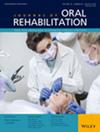Whether pain, jaw function and quality of life are correlated with disc positions is controversial, and similar studies evaluating disc positions by magnetic resonance imaging (MRI) are very limited.
This study evaluated the pain, mandibular function and quality of life of the temporomandibular disorders (TMDs) patients with different disc positions according to MRI, and the relationship among them.
Three hundred and thirty-five participants were included. Patients completed questionnaires included the Numeric Rating Scale (NRS), Jaw Functional Limitation Scale 8-item (JFLS-8), the Generalised Anxiety Disorder 7-item (GAD-7), Patient Health Questionnaire 9-item (PHQ-9) and Oral Health Impact Profile for TMD (OHIP-TMD). MRI was conducted to evaluate these diagnoses, resulting in the identification of three distinct categories: normal positioning (NP), disc displacement with reduction (DDwR) and disc displacement without reduction (DDwoR).
Participants had the mean age of 28.55 ± 11.10 years (80.90% women). DDwR and DDwoR had a higher percentage of females compared with NP. Significant differences existed among patients in all questionnaires. The DDwoR group had significantly the highest pain, functional limitation and the worst quality of life. Moreover, they experienced the most difficulties in chewing tough foods, yawning, experiencing pain and psychological discomfort. Moreover, the multivariate regression showed that age, female gender, diagnosis as DDwoR, GAD-7 and PHQ-9 were significantly linked to higher functional limitation. Worse quality of life was associated with age, diagnosis as DDwoR, GAD-7 and PHQ-9.
Among patients with different disc positions, DDwoR showed the highest pain, functional limitation and the worst quality of life. Also, NP showed a proportion of chronic pain. Physical pain, psychological discomfort and chewing tough food were regarded as the most impaired. Women who experience anxiety and depression tended to have a higher propotion of dysfunction and a lower quality of life.



